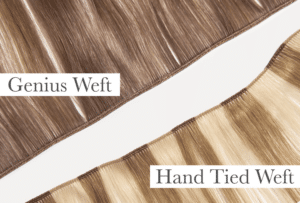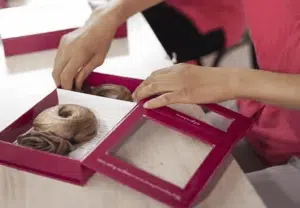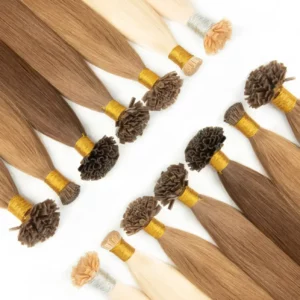Worried about your clients sleeping with hand tied extensions and waking up with tangles, matting, or discomfort? You’re not alone — and the good news is, there’s a smart, stylist-approved way to protect both the hair and the install overnight. Whether you’re running a salon or educating your team, this guide will give you everything you need to confidently guide your clients on nighttime hair extension care.
Yes, clients can safely sleep with hand tied extensions — if they follow the proper nighttime care routine. To prevent tangling, tension, and premature damage, they should loosely braid or ponytail the hair, use a silk pillowcase or bonnet, and brush gently before bed. These steps maintain extension integrity and comfort.
But that’s just the basics — if you want to avoid friction, shedding, matting, or complaints from high-end clients, you’ll want the full professional breakdown. Keep reading for stylist-level insights and a ready-to-use care routine you can pass on directly to clients.

Why This Guide Matters
Sure, extensions are meant to blend, move, and behave like natural hair. But they don’t have the scalp oils or root structure to self-repair after a rough night. Educating your clients on proper sleep care is not just an add-on—it’s an essential part of your service as a professional.
How Hand Tied Extensions Behave During Sleep
Let’s start with the root of it all (pun intended).
Natural Hair vs. Extension Hair
Natural hair is constantly nourished by the scalp’s natural oils. Extensions? Not so lucky. Sleeping without protection causes friction and dryness.
What Happens Overnight
When clients toss and turn, the wefts experience tension. Without protection, the stitching or beads take on strain, risking slippage or uneven root tension. That tension can also cause their natural hair to weaken, especially if they’re not brushing daily.

How to Sleep With Hand Tied Extensions
1. Detangle First, Always
Use a loop brush or wide-tooth comb. Start from the ends and work your way up to minimize root stress.
2. Secure the Hair
Go with a loose side braid, twin low braids, or a soft scrunchie ponytail. It protects the root area and reduces knots.
3. Switch to Silk or Satin
Cotton pillowcases absorb moisture and cause friction. Recommend silk or satin pillows—or better yet, a silk bonnet or scarf.
4. Dry Hair Only
Never let your client sleep with damp or wet extensions. It weakens thread tension and invites mildew.
5. Bonus: Overnight Serum
For full cuticle hair, a tiny drop of lightweight serum on the mid-lengths and ends will help reduce dryness, especially in air-conditioned rooms.
Consequences of Skipping Nighttime Care
| Mistake | Consequence |
| Sleeping with wet hair | Slippage, mildew, weakened tension threads |
| No braid or ponytail | Matting, tangles, knots, frizz |
| Cotton pillowcase | Dryness, friction, breakage |
| No brushing before bed | Root tension, bead movement, tangles |
| Tight elastics | Hair breakage, weft damage |

Long-Term Results of Proper Sleep Care
It’s not just about avoiding damage—good sleep habits extend the life of luxury extensions. Full cuticle hair can last 9–12 months or more with proper maintenance. Compare that with Remy hair, which lasts 4–6 months.
Summary for Clients:
- Brush thoroughly every night
- Secure with a braid or scrunchie
- Use silk or satin pillowcases
- Always sleep on dry hair
- Book regular maintenance appointments
What Stylists Should Do
As the professional, your responsibility doesn’t stop at the install. Offer every client the resources to protect your work.
- Include sleep instructions in your post-appointment care packet
- Sell silk pillowcases and scrunchies as retail items
- Bundle a brush and serum in a branded aftercare kit
These small steps elevate your service—and drive referrals.
FAQ: Sleeping With Hand Tied Extensions
Q1:Can clients sleep with wet extensions?
A1:No. Wet hair weakens bonds and may cause mildew at the weft seam.
Q2:Is a bonnet necessary?
A2:Optional, but highly recommended—especially for curly or blonde extensions.
Q3:What if they toss and turn a lot?
A3:Recommend two loose braids and a silk pillowcase to minimize friction.
Q4:Is a silk scarf a good substitute for a pillowcase?
A4:Yes. A silk scarf wrapped around the head provides excellent protection, even while traveling.
Q5:When should silk pillowcases be replaced?
A5:Every 6–12 months, depending on wear. Recommend weekly washing in a mesh laundry bag.
Q6:Should clients re-braid hair if it comes undone overnight?
A6:Yes. Re-braiding helps prevent early morning tangles and keeps the wefts aligned.
Q7:Can sleeping wrong reduce hair lifespan?
A7:Absolutely. Poor sleep care leads to tangling, frizz, and bead slippage—all of which shorten the life of the hair.
Q8:Is overnight oiling okay?
A8:Yes, but only mid-lengths to ends. Lightweight oil only. Never apply at the root.

Final Thoughts: Sleep Smarter, Not Harder
Proper sleep care for hand tied extensions isn’t optional—it’s essential. When clients understand how to maintain their hair at night, your installs stay flawless and your brand stays strong.
Empower them with the right tools, and your work will continue turning heads—every morning.





